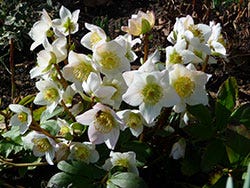Plants are blooming early due to unseasonably warm weather in Columbus

While the calendar and the groundhog each indicate that there are nonetheless six weeks of winter left, several vegetation in Greater Columbus are being fooled into considering that it is spring and have begun to break dormancy, many thanks to above-average temperatures seasoned in the place and during Ohio this wintertime.
Everyday temperatures in Bigger Columbus are averaging 2 to 4 levels Fahrenheit warmer than typical and the month of January was the third-warmest on history since 1895. Soil humidity is sufficient following a dry December and earlier mentioned normal precipitation in January.
This is what gardeners need to know.
A lot more:Columbus could attain record temperatures on Wednesday
Spring flowers are blooming in winter season
As a final result of this unseasonably moderate wintertime temperature, numerous species of early spring bouquets have begun to increase and will bloom pretty early this yr. Hellebores these types of as Lenten Rose have now started to flower in central Ohio, a lot before than typical. We can assume crocus, hyacinth and daffodils to accelerate stem development and flower improvement swiftly now, and bloom up to a month before than regular. Witch hazel is at this time blooming on the Ohio State College campus, and forsythia will possible bloom quickly.
Trees could be in peril
Buds on some species of shade trees and fruit trees have begun to swell with some early bloomers. It appears silver maple could flower this month if heat temperatures persist. Buds on some fruit trees have also begun to swell early in preparation for flowering.
Although a return of cooler temperatures could place the brakes on bud swell on some trees, the risk is that a continuation of warmer temperatures will bring about continued enlargement of buds and early flowering, making these trees inclined to a late wintertime or early spring freeze even though they are flowering. This form of climate sample is specially harmful to fruit trees these as peach. While most shade trees and ornamentals can endure freezing temperatures during flowering, freezing temperatures will lead to blossoms to slide from peach trees, terminating fruit manufacturing for the season. Some blossoms on apple and pear trees commonly survive a late-season freeze.
Additional:Get suggestions for the expanding season at the Dispatch Spring Residence & Backyard Show
Convert up the garden mower
The hotter daytime temperatures and awesome overnight temperatures are perfect for expansion of amazing time grasses, which make up most lawns. We can expect earlier green-up of lawn grasses this yr, and this time may perhaps be a single exactly where we will want to begin mowing the garden in March as a substitute of April.
These temperatures also are conducive to advancement of cool season garden weeds this sort of as chickweed and purple deadnettle, each of which are actively developing in Increased Columbus. These weeds might overrun sparse stands in lawns this spring, but control with herbicides is not commonly powerful in winter.

Great time greens
The beginning date for planting great season vegetables these as greens, peas, inexperienced onions and many others outside will likely happen before this year if existing climate designs persist. While the previous adage implies that we start out planting peas on St. Patrick’s Day, nervous gardeners may be capable to start off planting peas and other cool year vegetables a couple of months before than typical this calendar year if soil conditions permit.
As gardeners, we really should be expecting that weather extremes such as unseasonably warm weather conditions in wintertime will turn out to be additional commonplace with a modifying weather. Like the crops we like, we will will need to adapt to these adjustments in our natural environment.
Mike Hogan is Extension educator, Agriculture and Normal Assets, and associate professor with Ohio Condition University Extension.